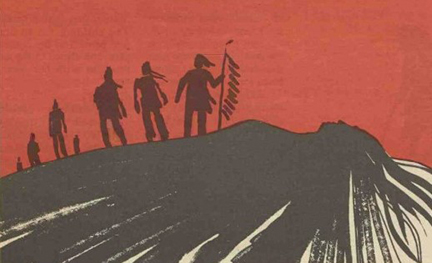
Adapted from a story by Dr. Anne Anderson, originally published in Windspeaker in 1988.
Long ago our people lived from the natural resources of the land and from the beliefs that they practised. In those days, for people to be respected they had to have knowledge of the use of medicine for protection.
One day, a dispute began when a medicine man named Chepwasin, who was from a northern community, asked an elderly couple from a more southern village for the hand of their lovely daughter Nawakesis. The medicine man wanted this young woman to be his son’s partner, but her parents refused.
This angered Chepwasin to have to return home with his rejected son Wasehkwan, so a scheme for revenge was hatched in Chepwasin’s mind.
Upon reaching his home, Chepwasin gathered all the great medicine men together for a conference and they were all angered upon hearing of the refusal, but they knew that the mother of Nawakesis was a powerful sorceress so the medicine men decided that preparation for her destruction should be taken carefully.
Throughout the winter the medicine men schooled themselves in the powers that their intended victim had and what they needed to be careful about. Finally in the spring season they gathered to put their plot into action.
The war ceremony was held in the sacred longhouse of the village where a wood carving in the likeness of the old woman was erected in the centre of the room.
The medicine men were seated on both sides of the longhouse. Throughout the evening they beat on the drums and sang songs to the spirit world. Others danced around the wooden figure until the leader called a halt. Then he took his old flintlock rifle and fired at the wooden statue embedding a slug into its leg. The ceremony was over and now the old woman was going to pay for her insult to Chepwasin and his son.
In the southern village, everyone was asleep when the old woman, the mother of Nawakesis, began to scream, a sound that had her family rush to her side. In her leg they saw a huge slug that had appeared under her skin without a wound.
Her husband quickly took out his knife to remove the slug, but the old woman stopped him, saying she had been attacked by surprise and her fate was sealed. There was no way to save her.
As she lay there, they saw that the slug was making its way upwards. Through gasping breath, she refused any effort to save her life. And she made a vow.
“I have been wronged. My life has been taken for no reason. Before this summer is over, more than half of their population will perish,” she said.
As she was dying, she asked that her family take her outside of their tipi to meet someone. They were ordered to leave her alone. As they waited inside, they heard a great howl from a wolf that shook the tipi. The wolf was the old woman’s spirit guardian and was mourning her death.
Her family could hear the beast circle the tipi several times and then the howling faded off into the distance towards the north. When the family finally went out to investigate, the old woman was indeed dead.
Now, the few people in that northern village where Chepwasin and his son lived still recall the incident. They say that one evening the terrible howl of a great wolf was heard in the forest. It brought fear into the hearts of all who heard it. Then came a strange plague that destroyed most of the people who lived there.
Everywhere people were dropping dead, attacked by an unknown force. A person would suddenly buckle, gasping and coughing up blood mixed with insects of all kinds. All these creeping things were spreading throughout the entire village.
Those that survived tried to move the camp, but that didn’t solve the problem for very long. The attempts of the great medicine men of the village to hold back the plague were useless. They themselves were dying inside their shaking tents.
Finally, the few remaining leaders decided to take the people down river to the old woman’s village in the south to beg for mercy. On their journey, every time they broke camp they left behind more graves. All during the trip they could hear the howling of the spirit wolf close behind them, digging up the graves and devouring the corpses.
Chepwasin’s son had survived the plague, but he announced that he too would die soon. He asked not to be covered too deeply in his grave because he intended to rise after death and go into the beyond in both body and soul. His death came swiftly, and his request was carried out when he was laid to rest.
When the now small band of fleeing people approached their southern destination, they noticed the wolf had turned back and the deaths had stopped. In the southern village they were welcomed, and they stayed for the summer.
In the fall they were concerned for their hunting grounds and left to go back north. On the journey they thought about the words of Chepwasin’s son Wasehkwan. They found his grave empty and his canoe a few miles upstream. There, high on a cliff, it rested where he had sacrificed his body and soul to break the old woman’s curse.
*****************************
Windspeaker is owned and operated by the Aboriginal Multi-Media Society of Alberta, an independent, not-for-profit communications organization.
Each year, Windspeaker.com publishes hundreds of free articles focused on Indigenous peoples, their issues and concerns, and the work they are undertaking to build a better future.
If you support objective, mature and balanced coverage of news relevant to Indigenous peoples, please consider supporting our work. Whatever the amount, it helps keep us going.
